Subtotal: $
Checkout-

Excerpt: Freiheit!
-

Did You Kill Anyone?
-

Poem: “Candid”
-

Poem: “March Thaw”
-

The Minimalist
-

Call to Prayer, Call to Bread
-

Editors’ Picks: “Charis in the World of Wonders”
-

Editors’ Picks: “The Reindeer Chronicles”
-

Editors’ Picks: “I Ain’t Marching Anymore”
-

Editors’ Picks: “Floaters”
-

Poetry You Can Touch
-

Poem: “Annuals”
-

Poem: “The Widow Offers Herself to Life”
-

Poem: “Mary Magdalen Responds to the Harsh Judge”
-

Poem: “In Retrospect”
-

Poem: “A Backward Look”
-

Poem: “Where Nectar Was”
-

Felix Manz
-

Covering the Cover: The Violence of Love
-

The Case for Meekness
-

Forum: Letters from Readers
-

Learning Generosity in Syria
-

A Tireless Peacemaker
-

Turning a Corner
-

Behind the Black Umbrellas
-

With Love We Shall Force Our Brothers
-

The Risk of Gentleness
-

The Great Escape
-

Militant Peacemaking
-

Peacemaking Is Political
-

Beyond Pacifism

When I was six, our family moved within walking distance of my grandparents, and I loved visiting them several evenings a week. I would spend the time playing checkers with Opa, my grandfather, while Oma busied herself making us a plate of food: usually some slices of the hard, fermented German sausage that always hung on the sideboard, with a cup of maté, a South American tea, for Opa. The melding of cultures seemed normal to me, as was Opa and Oma’s lapsing into Spanish or German when they wanted to speak privately. As I grew, we moved on to chess, then various card games, and ultimately settled on conversation. Opa didn’t like to talk about himself, and even less about his past, but when the stories did come out they were captivating. Over time I began to piece together the route by which he’d acquired such diverse cultural tastes. I learned how the twists and turns along the way had been driven, in large part, by a committed opposition to violence in all forms. Opa was an ardent conscientious objector himself. But resistance to war had shaped his life from the cradle.
Jakob Gneiting was born in Germany in 1933, at the Bruderhof, a Christian intentional community on a farm in the Rhön Mountains. His father, Alfred, had grown up in a socialist family. Despite finding the established churches too dismissive of social inequities, Alfred felt drawn to Christianity. In 1924, a friend encouraged him to visit the Bruderhof community, founded four years earlier with the goal of living out the practical implications of Jesus’ Sermon on the Mount. Alfred was inspired by the community’s vision, but wasn’t ready to commit himself. Following several years of coming and going and the patient conversation of Bruderhof founder Eberhard Arnold, Alfred finally decided to join. Shortly thereafter, Gretel Knott answered a newspaper advertisement for employment at the community, which needed a kindergarten teacher. Also inspired by the Bruderhof’s witness, she joined within a few years. Alfred and Gretel were married in 1931. Jakob was the first of their seven children.
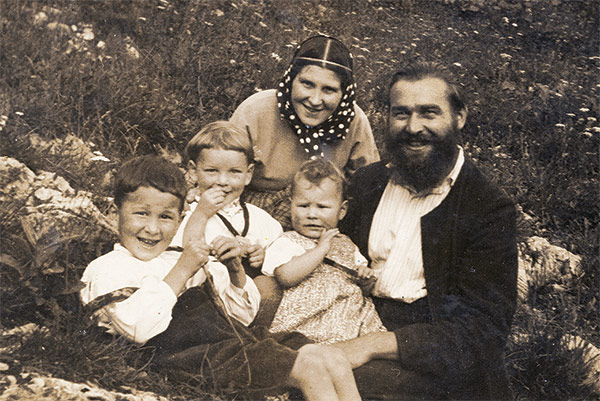
Jakob, left, with his parents and siblings on the Alm Bruderhof, Liechtenstein, 1936 All photographs courtesy of Bruderhof Historical Archive
From its inception, the Bruderhof had been committed to conscientious objection to all participation in violence and war.1 The Bruderhof took part in many of the peace conferences that were held under the auspices of the International Fellowship of Reconciliation. Over time, members sought out connections with others holding the same convictions: Quakers in Britain, Dutch Mennonites, Dietrich Bonhoeffer.2 Eberhard Arnold had studied the first Anabaptists, and the pacifism and communitarianism of the sixteenth-century Hutterites in the Tirol had a particular influence on the Bruderhof. Like these original Anabaptists, the Bruderhof found themselves in a Europe repeatedly convulsed by war.
By 1933, the Bruderhof and the Third Reich were already squaring off in opposition. Nevertheless, the Bruderhof pressed on in its vision of demonstrating the nature of God’s coming kingdom. Late that year, community members wrote to various government officials requesting accommodation of their pacifist position. To Reich President Paul von Hindenburg, they wrote, “Our brotherhood requests that it may serve the German Reich and its government in works of love as a traditional German Christian community in the way that the Hutterian Brethren have done faithfully for four hundred years, without taking part in military, political, or judicial actions.” Members of the community had all participated in drafting the letter. “What makes me especially happy,” Alfred said about the text, “is that the two tasks have been differentiated so clearly: the task of the church and the task of the state. It is a powerful witness.”3
Pacifist Refugees
As the Nazi party consolidated power in Germany, the gulf between the community and the government deepened.4 In 1934, after refusing to allow a Nazi teacher in its school, the Bruderhof started a second location outside Germany, the Alm Bruderhof in Liechtenstein, and sent all school-aged children to live there. In February 1935, on a sales trip, Alfred heard rumors of impending military conscription. Recognizing that the Nazis were unlikely to respect its beliefs, the Bruderhof decided to send all twenty-four men of military age to Liechtenstein as well. Quietly, members started collecting bicycles and obtaining passports (a delicate task). The official announcement came on March 16, 1935. Alfred and the others set out that night, making their way by bicycle and train to the Alm Bruderhof. Their wives and children (Jakob was not quite two) joined them on April 3.
Asylum in Liechtenstein was only temporary, however. Given the tiny country’s size and location, Prime Minister Josef Hoop informed the Bruderhof that the government would be unable to protect German citizens for long. The Bruderhof sought yet another haven, and eventually located a farm in Ashton Keynes, England. Alfred was one of the first members dispatched to start this new venture, the Cotswold Bruderhof, in early 1936; Gretel and the children followed some months later. Germany declared conscription of citizens living overseas in January, and the German embassy began asking Liechtenstein for status updates on the Bruderhof men. But by October 3, Prime Minister Hoop was able to inform the German embassy that there were no more draft-eligible German men at the Alm Bruderhof; they had all escaped to England. By the end of 1937, all community members had relocated to the Cotswold Bruderhof.
The welcome they received in England was decidedly mixed. The Bruderhof connected with many members of the interwar pacifist movement, through organizations like the Peace Pledge Union. But once the Second World War broke out and anti-German sentiment spread, neighbors of the Cotswold Bruderhof concocted fabulous tales about what these new German émigrés were doing – building a submarine in their gravel pit, poisoning the Thames – and repeatedly expressed negative opinions in the local papers. The Bruderhof’s pacifist stand exacerbated this xenophobia. When Britain introduced mandatory military training for young men in 1939, the Bruderhof published a statement in its magazine, The Plough, that “under no circumstances will any member of our communities join the fighting forces or do any alternative form of service.”5 Ultimately, all members of the Bruderhof who were called up received unconditional exemptions (remarkable considering that the British government granted only 2,900 such exemptions during the course of the war).
It was a position bound to provoke, and to be misunderstood: many in England associated pacifism with Neville Chamberlain’s appeasement policy, or even with tacit support for Nazism. Nevertheless, members of the Bruderhof endeavored to “devote all our resources to the prosecution not of war but of peace and brotherhood among men, which we feel is the best expression of gratitude we can give to this country.”6 This took practical form in varied ways, such as taking in Jewish refugee children, publishing The Plough, and maximizing agricultural production for the benefit of their neighbors.
“Under no circumstances will any member of our communities join the fighting forces or do any alternative form of service.” The Plough, 1939
The Bruderhof’s stand on conscientious objection eventually forced it out of England. Letters to the local papers decried “British cowards” joining the community, and a boycott drastically reduced its income. These voices in the local and national press, and eventually in Parliament, became too strong to ignore; the Bruderhof realized the government could not afford it protection much longer. German members also lived under threat of being interned as enemy nationals. This was untenable, as the community felt it a matter of faith to remain together.
This prompted a frantic search for yet another refuge. Initial overtures to Canada were rebuffed, as well as to other Commonwealth countries such as Australia, South Africa, and Jamaica. In August 1940 two members, British attorney Guy Johnson and Swiss engineer Hans Meier, tried to secure immigration permission in the United States. With the help of a Mennonite relief organization, they were able to meet with the State Department and even First Lady Eleanor Roosevelt. But because there was no provision for group immigration and a commitment to conscientious objection was sufficient legal basis for denial of immigration, these efforts proved fruitless.
The relationship with the Mennonites, however, yielded a path forward. In the wake of World War I, the government of Paraguay, whose population had been depleted by earlier wars, had granted a group of Canadian Mennonites a blanket exemption from military service; by 1940 they, along with an influx of Mennonites fleeing Russia, had established a significant foothold in the country. While Johnson and Meier were in the United States, a Mennonite representative arranged a meeting with the Paraguayan ambassador to the United States, which led to assurances that the Bruderhof would be welcomed on similar terms. When the community in England heard that this was likely its only option, many members were apprehensive: life in a remote jungle was not what they had anticipated when they set out to be a force for peace in society. But they remained resolute in their determination to live out their faith as one undivided church. In November, Jakob and his family set out in the first of several groups bound for their new home.
Building Up an Alternative
Freed from the threat of conscription, the Bruderhof could focus entirely on its initial inspiration: building a community to serve its neighbors. The first project was a hospital. Over the next twenty years, it provided a wide range of services, from maternity care to surgery, for tens of thousands of Paraguayans. At the same time, the community’s trained agriculturalists were applying their skills in the new environment; one successful project was breeding hybrid Zebu-Friesian cows that could produce milk in the harsh climate. In 1946, mindful of its own historical hardships, the community began a project to provide refuge for war orphans from Germany. After initial inquiries seemed positive, the community built up a separate settlement designed to care for and educate sixty children. Ultimately, the project was scuttled by the German authorities. Instead, the community used the facilities (and many members’ own homes) to provide accommodation for almost twice that number of Europeans displaced by the war.
Living as committed pacifists in a society resembling the Wild West often required creativity. The young men would take turns as night watchman, walking the compound with a lantern. Besides keeping fires stoked and waking the milking crew early, the watchman had to scare off wild animals and the occasional pilferer. One member was shot in the leg upon lighting a lamp after hearing thieves outside.
The government offered little protection, due to its own instability. At the start of one revolution, Jakob found himself in Asunción, the capital city. The Bruderhof house in the city was near the naval academy and the city police station. One night, gunshots awakened the household as the naval commander led a march on the police. When Jakob ventured out the next morning, the façade of the police station was so pockmarked with bullet holes that little paint remained.
There were several such revolutions during the Bruderhof’s sojourn in Paraguay. It was not uncommon that both sides requisitioned community livestock, both horses and cattle, sometimes with a promise to pay later. The community livestock manager was often dispatched to attempt to reclaim goods – nonviolently, of course. When the local commander was a neighbor, a well-timed bottle of caña was sometimes effective. (One time the commander thanked by offering a portion of beef off the fire, fresh from the Bruderhof’s herd.) Another time, a commander agreed to return several horses but not their valuable harnesses. The Bruderhof members found their distinctive tack in a storage shed, harnessed up the horses, and thanked the commander (in front of his guests) for his generosity in returning it to them. They got away before the commander could figure how to restrain them without losing face.
Despite its remoteness, the community received a regular stream of visitors. In keeping with its commitment to live a life that transcended political and economic divisions, it welcomed guests of all stripes: Jewish refugees, wealthy Philadelphia Quakers, two brothers from Rhodesia bicycling around the world. Jakob spent the summer of 1955 rooming with Frederic Pryor, a visiting Oberlin student later imprisoned in East Germany and freed along with downed American U-2 pilot Francis Gary Powers in exchange for a KGB agent, as dramatized in Steven Spielberg’s 2015 film Bridge of Spies. One Belgian family arrived with their servant Juliana Alonzo, a Paraguayan girl of indigenous Guaraní descent.7
Many of these visitors, including Juliana, decided to join the community. As Jakob came of age, he and many of his peers made the commitment for themselves as well. (In the Bruderhof, only adults can enter into full membership, on the basis of a free individual decision.) On one youth group outing in Paraguay’s cold season, Juliana’s warm-hearted nature caught Jakob’s attention when she gave away her only coat to a young woman who was shivering. A friendship between the two developed, and they were married in 1957.
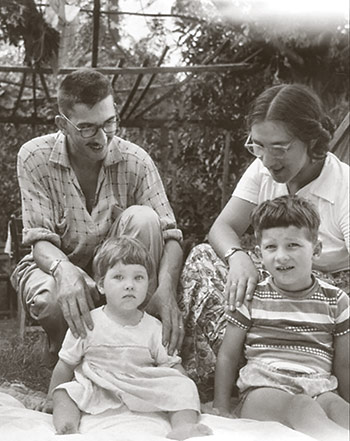
Jakob and Juliana with two of their children, 1960
In 1953, Bob and Shirley Wagoner, a couple from the Church of the Brethren, one of the historic peace churches, had visited the Paraguay community for six months. Bob, a theology student, was distressed that some eighty percent of Brethren young men had joined the military during World War II. He hoped that a recommitment to nonviolence would reinvigorate the American denomination. The Wagoners’ letters home (later published as Community in Paraguay), raised awareness of the Bruderhof in the United States and contributed to a surge in American visitors to Paraguay.8
Many were conscientious objectors. In 1955 Milton Zimmerman, a young Quaker doctor from Philadelphia, was the first to obtain approval to work in the Bruderhof hospital as an alternative to military service. The Bruderhof had also opened its first US location, Woodcrest, in 1954, and many young Americans who had been conscientious objectors in World War II and the Korean War found welcome in the community. So did a number of military veterans troubled by what they had experienced in the war. This influx of enthusiastic and inspired people with new ideas invigorated Bruderhof life. Over the next eight years, the locus of the community shifted to the United States (with additional locations reestablished in postwar England and Germany). Jakob and Juliana moved to the United States in 1961.
The American Tradition of Liberty of Conscience
Accommodation of conscientious objectors has been an issue from the beginning of the American experiment. As a three-time immigrant who ultimately ended up in the United States, my grandfather would be the first to gratefully acknowledge the freedom of conscience guaranteed in this country. I thought often of his experience during a law-school seminar on the origins of the Bill of Rights. These protections were not inevitable, and still need defending today.
As early as the 1670s, several of the American colonies granted exemptions to Quakers seeking to avoid militia service.9 Of the thirteen colonies, eleven had constitutions including a form of bill of rights, all of which included protection of some kind for an individual’s right of conscience. These exemptions continued through the Revolutionary War. In 1789 George Washington, who had commanded the Continental Army, wrote to a gathering of Quakers who had expressed a desire to remain free from participation in war, “I assure you very explicitly that in my opinion the Conscientious scruples of all men should be treated with great delicacy & tenderness, and it is my wish and desire that the Laws may always be as extensively accommodated to them, as a due regard for the protection and essential interests of the nation may justify and permit.” 10
But at the same time, there were strong philosophical disagreements about conscience rights among the founders. John Locke, the English philosopher most influential on the founders’ views, trusted that government would be wise enough to avoid imposing burdens on individual conscience. Though Locke advocated that people follow their consciences, he assumed they would be subject to penalties existing under the law (conscientious objection to military service was just one of several expressions of conscience at issue at the time). Among the founders, Jefferson supported this position, advocating for protecting beliefs but not necessarily actions that flow from those beliefs. Madison, meanwhile, took the more expansive view that the individual conscience was “the most sacred of all property” and ought to be accorded substantial latitude. Although Madison’s initial proposal to protect “the full and equal rights of conscience” as part of the First Amendment fell victim to compromise, it was Madison’s vision that substantially informed the First Amendment’s protection of religion, which gradually spread to other nations.
In my opinion the Conscientious scruples of all men should be treated with great delicacy & tenderness.
—George Washington, 1789
Congress has provided explicit protection for conscientious objection ever since it enacted the first federal draft in 1864. Both the Union and the Confederacy exempted members of certain denominations from military service. During World War I, this protection applied only to members of established peace churches, such as the Church of the Brethren, Quakers, and Mennonites, and still required induction into the armed forces as noncombatants. Those who refused were subject to military imprisonment and faced other mistreatment. 11
The World War II era saw much more emphasis on individual beliefs, rather than denominational association, in determining conscientious objector status. These men were assigned to unpaid “work of national importance” in Civilian Public Service (CPS) camps, which were under the purview of the Selective Service and outside the chain of command of the military. 12 The focus on individual beliefs in conscientious objector determinations increased through the Vietnam War era. In 1965 the Supreme Court, in perhaps its most extensive examination of what constitutes “religion,” broadened the statute to protect everyone holding a “sincere and meaningful belief which occupies in the life of its possessor a place parallel to that filled by the orthodox belief” in God. 13 This was later expanded further, to encompass all categorical objections to war, even if purely moral rather than religious. 14
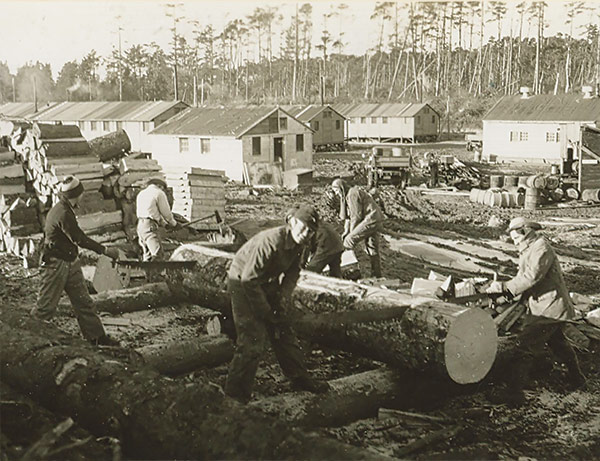
Conscientious objectors perform “work of national importance” during World War II in a Civilian Public Service camp, Waldport, Oregon.
Although the United States has maintained an all-volunteer military since 1972, there have been recurring calls for the return of a draft. Supporters have argued that a draft would distribute the burdens of war more equitably, and that a broader conception of national service would increase national unity. A bipartisan national commission formed in 2016 to address these concerns released its final report in early 2020. It endorsed maintaining mandatory draft registration, expanded to include women, while retaining an all-volunteer military. Recognizing the need for positive service opportunities outside the military, however, the report recommended keeping protections for conscientious objectors, and further, providing “service-year opportunities so ubiquitous that service becomes a rite of passage for millions of young adults.” 15 This included proposing a tenfold expansion of federally funded national service opportunities other than the military. Currently, there are fewer than 85,000 such positions available to young people – less than four percent of the number of active duty and reserve military members. And the commission called for improving incentives to these programs such as living stipends and educational benefits; these currently lag far behind those available in the military and put these programs (such as the Peace Corps and AmeriCorps) out of the reach of many young people. These changes would go a long way toward establishing a healthy culture of altruistic national service.
Even if opportunities for national service expand, however, there will still be a need for robust conscience protection. Disputes over the right not to kill are no longer confined to the armed forces. For example, they have surfaced increasingly in the healthcare professions: pharmacies have faced regulatory inquiry for allegedly violating professional standards and nondiscrimination principles when their owners refused to supply drugs that might be abortifacients; 16 writers in peer-reviewed medical journals have argued for rules requiring doctors to participate in euthanasia in the interest of individual autonomy. 17
Objectors to the Vietnam War
The American Bruderhof that Jakob and the other immigrants from Paraguay found on arrival had also been shaped by conscientious objection. Many alumni of the Civilian Public Service camps missed the sense of comradery and shared purpose they had found there, and joined or started intentional communities; quite a few (including my wife’s grandfather) eventually joined the Bruderhof. The community also befriended a wide spectrum of peace activists, from Dorothy Day to Eleanor Roosevelt.
As young men migrated from Paraguay or came of age in the United States, they too were subject to the draft. The CPS alumni were happy to mentor this new generation of conscientious objectors, through practical advice and stories. During World War II, eager to work for something positive and to demonstrate their conviction by putting their own lives on the line, many had volunteered for the most dangerous assignments. One of Jakob’s new compatriots had volunteered for a smoke-jumping unit, but was rejected for being ten pounds over the weight limit. Instead, he volunteered as a medical guinea pig. Twice army doctors intentionally infected him with hepatitis as part of a study of transmission and potential treatments of the disease. Others had served as research subjects in challenge trials of early flu vaccines, receiving first the vaccine being tested, and then a dose of the virus itself.
Our lives already are conscripted for service in another Kingdom. This is our task, our first and only loyalty.
—Bruderhof statement, 1958
The older objectors’ advice and encouragement was invaluable, particularly for the first conscientious objectors from Paraguay. Once someone was called up, a local draft board made the initial determination whether he was sincere in his conscientious objection. Boards also had veto power over the alternative service an objector agreed to perform. (By this time, rather than group work in CPS camps, most were assigned individual jobs with nonprofits approved as “in the national interest.”) Boards were composed of local volunteers who generally had little sympathy for conscientious objectors and had a quota of men to supply the military. For Germans coming from a Spanish-speaking country, English was their second or third language, ill-suited for making nuanced arguments about personal conviction.
Nor was classification as a conscientious objector permanent. For example, when one young man obtained conscientious objector status on appeal and then attended college, Selective Service automatically changed his status to student. When he finished school, he was promptly reclassified as available for conscription, necessitating yet another (successful) appeal.
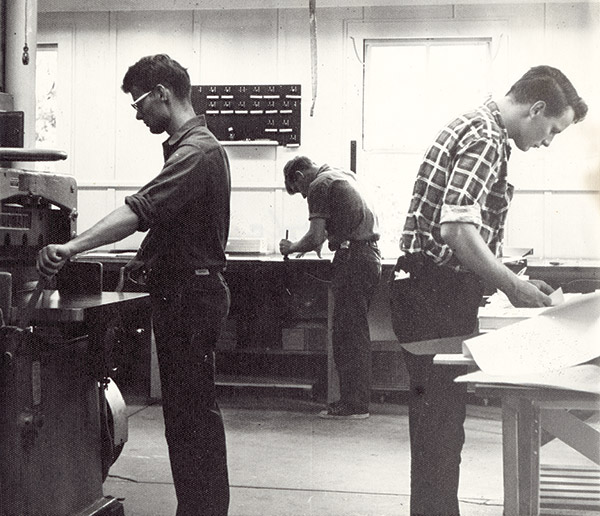
Young men fulfill their alternative service requirements by working in Plough’s printshop, ca. 1967.
Through all this, the Bruderhof remained clear that its primary goal was living a life guided by the Sermon on the Mount. Although the community members were unanimous that they would not serve in the military, even as noncombatants, they debated what alternative service their beliefs permitted. Considering this question at a members’ meeting in 1958, the Woodcrest members were clear about their priorities: “We recognize that we already have the foundation principle which is the basis for evaluating each situation of relationship to government.… Our lives already are conscripted for service in another Kingdom. This is our task, our first and only loyalty. We cannot heed any call or order that would take us from this task.”
Eventually, the community decided to explore Bruderhof-sponsored alternative service, so young members could fulfill both obligations at once. The Bruderhof’s hospital in Paraguay had already been approved, so some Bruderhof members did alternative service there until it closed in 1960. Following the example of the CPS camp veterans by seeking service that demonstrated that their opposition to war was not a result of cowardice, the Bruderhof also joined discussions about the formation of a nonviolent peacekeeping mission in North Africa under the leadership of André Trocmé and the International Fellowship of Reconciliation, in cooperation with the Mennonite Central Committee and the Brethren Service Committee. (In the end, none of the American groups saw the project to completion.) The Bruderhof ultimately had less daring activities approved as “in the national interest,” including teaching in the Bruderhof’s elementary schools. Work placements at Plough were also approved by the Selective Service after a rigorous vetting process confirming that Plough’s purpose to “call men to turn toward God in the midst of this very needy world situation” was indeed in the national interest.

Jakob, second from right, works in the Bruderhof’s furniture factory in Pennsylvania, ca. 1965.
Jakob was never called up, so was never officially required to perform alternative service. Still, like the rest of the community, he worked to live out an alternative to war. This took many forms. Beyond the community, it included years on the local volunteer fire department squad, regular visits to the jail, and working at the food bank the community operated. Within the community, it meant being among the first at the community’s workshop each morning (a habit he still maintains at age eighty-seven) while also serving the community as a pastor. For my grandmother, the most generous and loving person I know, it meant caring for her neighbors through small but practical acts of love; her well-tuned sense of the right gift at the right moment became legendary. Even while raising eight children of their own, their house was always open to visitors. It still is – not just to grandchildren, but also to young men and women seeking their own calling in life.
Beyond Resistance to War
In recent years the Bruderhof has started new communities in two countries that still have military conscription: South Korea and Austria. So young men from the Bruderhof will again be liable for military service. The similarities between these countries stop there, though, as their military regulations couldn’t be more different in their implementation.
South Korea has a long tradition of military service by all male citizens – not surprisingly, given that it officially remains at war with North Korea. Military service is a cultural rite of passage, and any attempt to avoid it is highly stigmatized and could ruin one’s career prospects. Until recently, the few who refused military service for religious reasons faced significant jail terms, followed by a lifetime with a criminal record. In 2018, however, the Korean Constitutional Court ruled that the country must make provision for conscientious objectors. Late last year, a group of sixty-four objectors began the first legally recognized alternative service outside the military chain of command: three years working in a correctional facility primarily as cooks and janitors. Many activists are relieved that, despite the punitive nature of the work, they have an opportunity to be of service to their country without violating their conscience.
In Austria, too, every male citizen is subject to compulsory military service. However, there is an automatic right to opt for civilian community service instead. A significant majority go this route, spending a year providing eldercare or doing environmental protection work. With these options, there is no need for special provisions to protect conscientious objectors.
Austria’s universal national service suggests the untapped potential of such opportunities in the United States and other countries. And the equitable application of conscription across society in both Austria and South Korea highlights the economic inequality of military service in the United States. The move to an all-volunteer military only accelerated an existing trend of unequal representation of the poor among military members (and resulting casualties). Beginning with near equality in World War II, each major conflict has seen a growing gulf between the average income of communities with high levels of war casualties and those with low levels. 18
To many of my high school classmates, the New York City that anchored 9/11 iconography was as foreign as Baghdad or Kandahar.
Attending high school shortly after 9/11 in one such low-income area, I was easily able to see why this inequality persisted. We lived in an impoverished county in southwestern Pennsylvania, and consensus among my classmates was that the only way to get ahead was to get out. Absent some special talent or advantaged parents, the military was an obvious path to achieving this. It was baked into the culture – the soundtrack on the school bus was militaristic country anthems such as Lee Greenwood’s “God Bless the U.S.A. 2003” and Toby Keith’s “American Soldier” – and reinforced by advertising on student television and at school events. Recruiters were regularly on campus, and they already had your information – if you hadn’t exercised your right to opt out, buried in fine text on page thirty-three of the student handbook, along with the opt-out for corporal punishment.
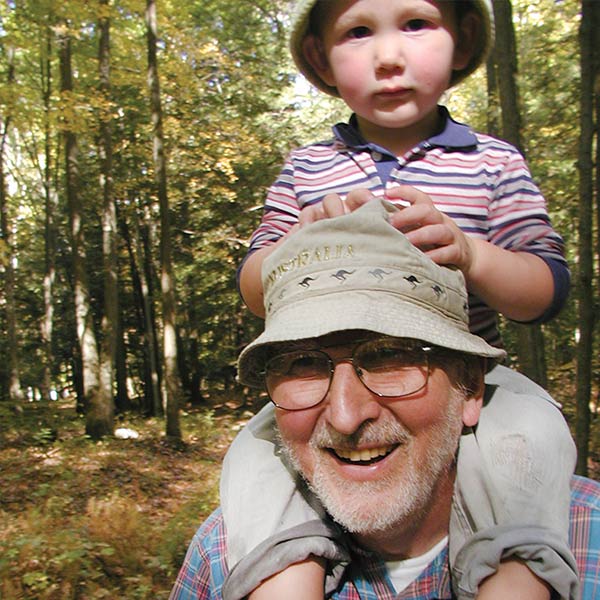
Jakob with a grandchild, 1990
Ironically, to many of my high school classmates, the New York City that anchored 9/11 iconography was as foreign as Baghdad or Kandahar. And unlike conscripts in South Korea or Israel, the national interest they were being asked to defend was far removed from their day-to-day life. Still, whether they dreamed of traveling the world or pursuing advanced training, for many of my peers the military could feel like the default option.
In the post-9/11 environment, a return to the draft seemed possible. This gave me pause – I did not have a firm faith, but was equally skeptical of the bravado and pageantry of the military ad campaigns. It was spending time with Opa that helped me understand that it wasn’t sufficient to oppose war; one must find a positive cause to advance. It wasn’t so much his words as his example. He kept up an active correspondence with communities around the world. At the same time, he was deeply invested in his local community. While his firefighting days were past, his efforts at pastoral and charitable care were redoubled. And Oma, with her quiet care for the unannounced guest and the struggling acquaintance time zones away, embodied a different version of the same commitment. In time, I came to share their quiet conviction that working toward living out the kingdom of God was a higher calling – and served one’s neighbor and humanity better – than any form of patriotism.
Our society will continue to encounter questions of conscientious objection, and it would do well to learn from its history. During the Revolutionary War, the Continental Congress appealed to a charitable understanding of common purpose, rather than overzealous mandates, in its conscription decree:
As there are some people, who, from religious principles, cannot bear arms in any case, this Congress intend no violence to their consciences, but earnestly recommend it to them, to contribute liberally in this time of universal calamity, to the relief of their distressed brethren in the several colonies, and to do all other services to their oppressed Country, which they can consistently with their religious principles. 19
Those of us who refuse to kill would do well to learn from our own storied history, and respond in the same spirit as our forebears to this call for relief of the distressed.
When I sit with Opa now, the stories are even fewer, but he retains his verve and conviction. Our conversation is marked by stretches of deep and wise silence, the quiet confidence of a life well lived, in service to others. And I am convinced, more than ever, to follow Opa’s example of living, in the words of the Quaker founder George Fox, “in the virtue of that life and power that took away the occasion of all wars.”
Footnotes
- See in this issue Stanley Hauerwas, “Militant Peacemaking” and Eberhard Arnold, “Beyond Pacifism.”
- Ian Randall, A Christian Peace Experiment: The Bruderhof Community in Britain, 1933–1942 (Cascade Books, 2018), 18–37.
- Emmy Barth, An Embassy Besieged: The Story of a Christian Community in Nazi Germany (Cascade Books, 2010), 90–93.
- See generally Thomas Nauerth, Zeugnis, Liebe und Widerstand (Schoeningh Ferdinand, 2017); Randall, A Christian Peace Experiment; E. C. H. Arnold, “The Fate of a Christian Experiment,” The Spectator (11 June 1937), 11–12.
- “The Brothers and Conscription”, The Plough (Summer, 1939), 61.
- “Our Members and the Tribunals,” The Plough (Spring 1940), 30.
- See “Juliana Gneiting” in Clare Stober, Another Life Is Possible (Plough, 2020), 26.
- Bob and Shirley Wagoner, Community in Paraguay (Plough, 1991).
- See generally Michael W. McConnell, “The Origins and Historical Understanding of Free Exercise of Religion,” Harvard Law Review 103:7 (1990), 1409–1517; Mark L. Rienzi, “The Constitutional Right Not to Kill,” Emory Law Review 62 (2012), 121–178.
- George Washington to the Society of Quakers, October 13, 1789.
- See e.g. Duane Stoltzfus, “The Martyrs of Alcatraz,” Plough Quarterly 1 (Summer 2014), 36–47.
- For more background, see CivilianPublicService.org.
- United States v. Seeger, 380 U.S. 163, 166 (1965).
- Welsh v. United States, 398 U.S. 333 (1970).
- Inspired to Serve: The Final Report of the National Commission on Military, National, and Public Service, March 2020.
- See e.g. Stormans, Inc. v. Wiesman, 136 S. Ct. 2433 (2016) (Alito, J., dissenting from denial of certiorari); see also Brief of the Bruderhof and the National Committee for Amish Religious Freedom as Amici Curiae Supporting the Petitioners, Stormans, Inc. v. Wiesman, 136 S. Ct. 2433 (2016).
- See e.g. Julian Savulescu and Udo Schuklenk, “Doctors Have No Right to Refuse Medical Assistance in Dying, Abortion or Contraception,” Bioethics 31:3 (2017), 162–170.
- See e.g. Douglas L. Kriner and Francis X. Shen, “Invisible Inequality: The Two Americas of Military Sacrifice,” University of Memphis Law Review 46 (2016), 545-635.
- Resolution of July 18, 1775, in Journals of the Continental Congress, 1774–1789, v. 2 (W. Ford ed., 1905), 187, 189.
Scott Button, a member of the Bruderhof, lives in Rifton, New York, with his wife and two children. He serves as the Bruderhof’s associate general counsel.
Already a subscriber? Sign in
Try 3 months of unlimited access. Start your FREE TRIAL today. Cancel anytime.









































Mary
Wow, thank you for this deeply inspiring article. I'm the mother of a draft-eligible son. I'm humbled to admit that, up until now, I have been completely ignorant about the history of conscription in the USA and other countries. This shows what a privileged background I come from. As I try to live our my faith in Christ in my own time and place, I'm spurred on by your example and your grandparents' lives of profound love. God bless you all.